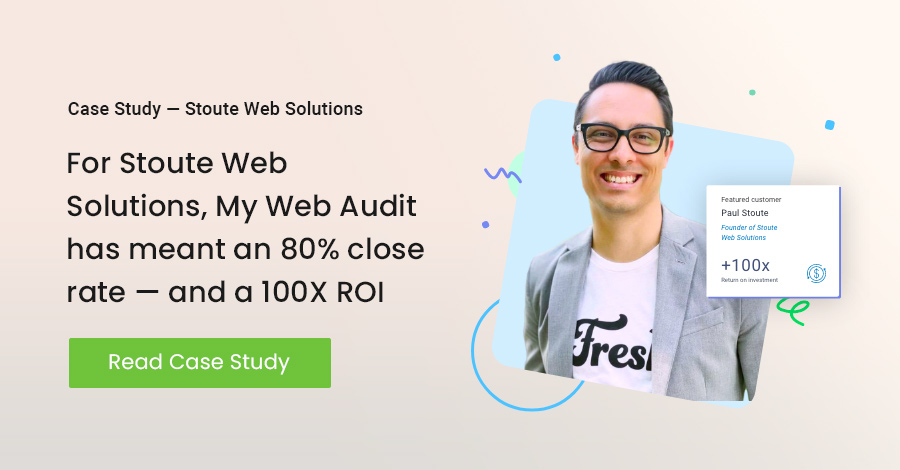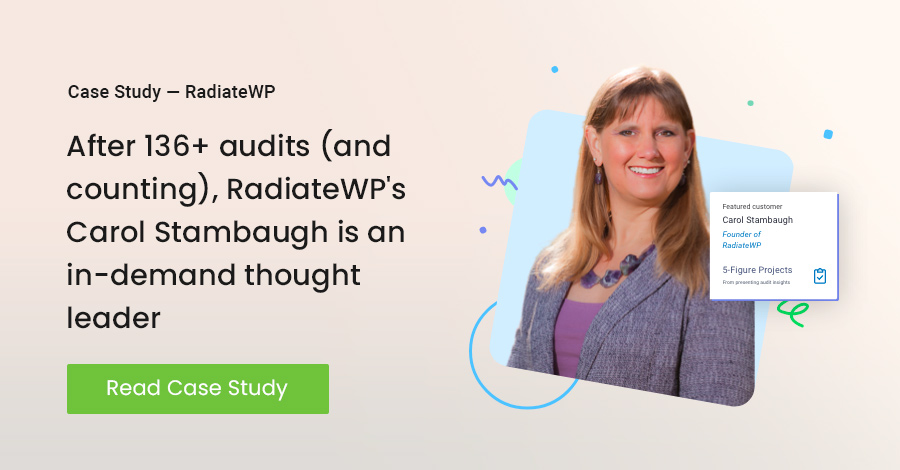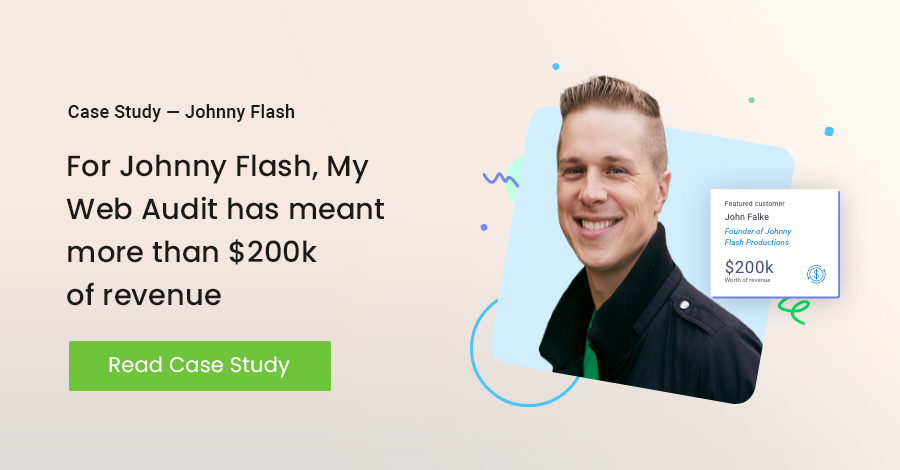
The magic method that works like crazy to close more web agency leads
What happens when your web agency gets a good lead?
Plenty of web agencies go all out and work aggressively to close that lead. They use high-pressure sales tactics or sell pipe dreams without even understanding what the prospect's expensive problems or pain points are let alone the solution. After a 30 or 60 minute meeting, they propose a solution that more often than not requires a big investment of time and money in the agency's core service offering. This usually leads to them losing the sale. Does this sound familiar?
Here's the issue...
We forget that in order to close a sale we need to establish your expertise, build trust and authority. This is really hard to do in a 30-minute meeting with a prospect who knows very little about you and your brand.
You don't propose to someone on your first date right?
In most cases, if the client wants to pursue a full-scale website or development project we recommend paid discovery as the next steps. For prospects who have made it clear, they aren't ready to make that investment but would like to move forward with us we use the "foot-in-the-door" strategy. It works like magic for us.
This is a psychological technique that's been proven to get people to take action or say "yes" to a request.
Here's how it works...
You start by presenting a small, "can't say no" offer to your prospects that deliver value and measurable results. The key here is to present something with a high value that requires very little time, money or risk from the prospect. This could be something you charge $99-$499 for and offer consulting time, audits to uncover growth opportunities or even a few hours of work to address some pain points they have. You may even be able to have an offer that is free, depending on how busy your agency is and how easy it is to execute the strategy.
Your prospect says yes to this request (after all, you've engineered this offer to make it very easy to say "yes" to). Metaphorically speaking, you now have your foot in the door. And as every old-school door-to-door salesperson would tell you, this is a good place to be.
Interested in the science behind all of this, learning about some proven foot in the door strategies and how you can create a few for yourself? Keep reading.
Does it really work?

You’ve seen how your own personal relationships progress (i.e., by starting small), and a business relationship is no different.
Yes, it does work – and scientists can prove it.
Various researchers have looked at this technique in a variety of ways, and over and over again the data says it works.
For example, one group of researchers randomly split subjects into two groups and then requested something from each test subject. The two groups looked like this:
Group 1: Researchers make relatively large request.
Group 2: Researchers make small request first, and then make the large request.
For example, in one study the researchers set out to see if they could get people to agree to a researcher coming to their house to catalog their household cleaning products.
For the first randomly selected group, researchers made the big request directly. As you might suspect, a lot of people (specifically housewives, since this was the 1960s) said no. After all, who wants strangers rifling around your cupboards?
For the second group, researchers made a small request first. Here they asked their subjects if they would complete a short phone survey about their cleaning supplies. Plenty of people said yes because it was an easy request to agree to.
Next, this group was then asked if they’d be willing to have someone come to their house to catalog their household products. A significantly larger number of people said “yes” to this request versus those in the first group. Asking for the smaller request first “greased the wheels” and primed people to say yes to the second request.
Other similar studies followed, and they all produced the same result. Namely, making a small request first makes it more likely that people will agree to your larger request later.
Want to learn more? Here’s another example… If not, skip to the next section.
For the first group, the researchers asked if they could put a big political sign in the homeowner’s yard. The majority said “no.” That was a big request from a stranger, so people weren’t keen to act on it.
For the second group of subjects, the researchers garnered a better response by using the foot in the door technique. Here they started by asking the subjects for a small favor, which was to put a small sign in their window. People said yes. Then later the researchers went back to those who said yes and asked if they could put the big (ugly) sign in their yard.
End result? Yep, you guessed it. People in the second group were much more likely to put the big sign in their yard versus those in the first group. Once again, that small initial request helped grease the wheels.
Those were the initial studies that kicked things of in the 1960s. Since then, researchers, marketers, psychologists, and others have shown over and over again that the foot-in-the-door technique is a good way to influence someone to take a specific action.
This brings us to the next question…
Why does it work so well?

The reason why the foot-in-the-door technique works so well is that it trips a set of psychological sales triggers.
Most importantly, it trips the “commitment and consistency” trigger. Let me explain…
People like to see themselves as consistent. It’s psychologically uncomfortable for most people to act in ways that aren’t consistent with how they think, feel or how they’ve previously acted.
When you get someone to commit to a small request, they’re going to feel obligated to see it through. And once they’ve seen it through, you’ve now tripped the consistency trigger. When you make your larger request, they’re going to say “yes” because they want to appear consistent.
Take the example of a business owner. Let’s say you offer them a website or SEO audit. By accepting the website audit, they are committing to the idea that a website is an important component of their business.
Now let’s suppose your website audit uncovers several problems. You offer your services to fix these problems. Your prospect is likely to say yes, because they want to be consistent. Part of the audit delivery includes you uncovering growth opportunities, explaining the value effectively and establishing your authority. If they thought the website page was important enough to audit, then for consistency’s sake they’ll believe it’s important enough to fix what you have clearly and effectively communicated to them. Especially if you align your insights with their pain points or goals.
That’s not all. Depending on what you’re offering, the foot-in-the-door technique may also trip the reciprocity trigger. Specifically, if you offer something for free – such as a website audit – then your prospects are going to feel obligated to do something for you. In this example, offering a valuable website audit results in the business owner hiring you to do the work and fix the issues uncovered in the audit or more of their time to learn why they should hire you to solve their problems.
Here’s why this works…
We are wired to want to do things for people who do something for us. You can study the reciprocity principle to learn more.
The same goes for your prospects. If you’re providing a lot of value to them for free (or even very low cost), they’re going to feel “obligated” to repay your kindness. And one way for them to do that is by hiring your agency. It works like magic!
You can see where all of this would be really helpful for your web agency to land new clients. So, let’s talk about how to do that…
Here's how to put this strategy to work for your web agency

The first key, as you know, is to start with a small request and make sure to align it with their biggest pain points or desired outcomes. Wondering how do you do that exactly? Simple, just ask questions like these:
What is the biggest issue you are having in relation to your website or business?
What does success look like? (Where do you want to be a year from now?)
As a web agency owner, you might propose something like a free or low-cost website, SEO, GMB or landing page audit to a client. It requires very little time, money or risk on their behalf, so they’re likely to say yes.
Here’s the second key: now that your foot is in the door, you need to make the most of it. You’ve got one chance to impress your client and show them what you can do for them, so you need to make the most of this opportunity.
That means you need to provide a lot of value. This is true whether you’re offering something for free or if you charged a small fee. You want to make your prospect or customer feel like they made a good investment of time and/or money when they agree to your request.
You don’t even need to “sell” at this point, as your focus should be on educating and helping your prospect. Once your clients see the tremendous value you provide, they’re going to be that much more eager to do more business with you. Add that to the fact that you’ve tripped the commitment/consistency trigger, and you have a powerful recipe for landing a whole lot more clients!
So, with that in mind, let me share with you a few of our web agency’s favorite ways to get a foot-in-the-door…
Website / ecommerce audit

If you have a prospect with a virtual storefront, then one way to get your foot in the door is by offering an e-commerce audit. This is where you show your prospects all the ways they can improve their e-commerce site so they rank better, get more traffic and generate more sales. Here is an example of the e-commerce website audit template we use.
This small request (the audit) is a natural step towards the larger request (doing the actual work required to make the changes suggested in the audit), this could lead to a website care plan, monthly development retainer, complete website rebuild or a digital marketing package. Either way, the end result should be tremendous value delivered to your customer and more revenue for your agency.
GMB optimization

If the prospect is wondering why they’re not getting much local traffic from Google. In many cases, it’s because they haven’t optimized their Google My Business profile. A profile that’s lacking in relevant details not only gets outranked by the competitors, it also doesn’t generate much interest even if someone does stumble upon it.
Offering Google My Business optimization is a great way to get your foot in the door because you can do this optimization very fast and at low cost, yet it can provide tremendous, near-immediate results for your clients. It’s also a great service to productize and delegate to a team member or VA. Here is an example of the Google My Business audit template we use.
On page SEO optimization

Another way to get your foot in the door is by offering an on-page search engine optimization audit to prospect looking to generate more website traffic using SEO. This audit will reveal problems with page titles, links, navigation menus and more. Once clients see all the potential problems with their pages, they’ll be eager to hire your web agency to fix these problems. This works great because you demystify SEO and show them vs. tell them how they can rank better. Here is an example of the On-Page SEO audit template we use.
And what happens after you’ve optimized your client’s pages? Your clients will be interested in your other services, such as an ongoing SEO retainer or doing conversion optimization to make the most of their newfound traffic.
Landing page audit

Most business owners are looking for ways to grow their business, and fast vs. waiting months for SEO traffic. Paid ads are a great way for them to do that. In fact, thousands of companies in your local city are probably driving traffic to poorly performing pages that aren’t converting.
That’s why offering a landing-page audit is so valuable to small business owners. This low-risk, low-investment request is perfect for helping your prospects and clients increase their conversion rates, reduce their lead/customer acquisition cost and improve their ROI. Here is an example of the Landing Page audit template we use.
This naturally paves the way to these business owners hiring your agency to complete the work that’s outlined in the audit, manage their site or even their PPC campaigns.
Page performance audit

A lot of web pages run slow, because they’re bogged down by clunky coding, autoplay media, unoptimized images, bad scripts and more. Not only does Google frown on slow- loading sites, but visitors do too. Your prospects and clients have just a few seconds to capture attention, and that’s not going to happen if their webpage hasn’t even fully loaded during that time frame.
Web agencies are getting an increasing number of leads for page performance services because of Google and other companies educating them on the impact of page speed on SEO, user experience and conversions.
That’s why offering a page-performance audit is so valuable to small business owners. And, just like the other audits mentioned above, it naturally leads to clients hiring your agency to do the required work. Here is an example of the Page Speed Optimization audit template we use.
Competitive analysis

Business owners succeed when they know what the competitors are doing so that they can adjust their digital strategy to gain a competitive advantage. We offer a competitive analysis to offer insights businesses can use to outmaneuver their competition. All of these insights directly correlate with our service offerings. We’ve found no better way to get a prospect or existing client to invest in one of our services than to show them what their direct competition is doing better.
That’s why smart business owners are eager to get a competitive analysis from you. It’s a good “small request” type offer since it provides a lot of value for the prospect or your client, and it’s something your team can easily do in a few hours or in a few minutes if you use the Competitive Analysis report template we use.
Conclusion
You just learned about the foot-in-the-door technique, why it works, and some of the best ways to put it to work for your web agency. Once you put it to work, you’ll quickly see how this magic method works like crazy to convert more of your prospects into high-value clients.
As mentioned above, offering various audits are among some of the best ways to get your foot in the door. You can offer them for free or low cost, which makes it easy for prospects to say yes. And they provide a lot of value, which paces the way to your client hiring you to complete the work uncovered in the audits.
If you’ve ever offered audits before, then you may have found the old-school way of doing them fairly time-consuming. You probably used multiple tools to create them, and you then had to rewrite the copy so your audience could understand it and reformat the whole thing to make it presentable. That may have felt like a lot of work for little reward.
The good news is that you can now offer beautiful, actionable, and easy-to-understand audits that help you close more deals by using just one tool and a few clicks of your mouse. Instead of spending hours or days creating reports, your team can now focus on growing your agency.
To find out how to quickly start creating impressive audits for your prospects and clients, visit My Web Audit now at https://www.mywebaudit.com.
You may also like

Black Friday + Cyber Monday deals for agencies
Black Friday is the ultimate opportunity for freelancers and agency ow...
Learn more
Agency Guide: How To Generate Leads From Trade Shows & Conferences
Trade shows and conferences can be great opportunities for agencies to...
Learn more




















